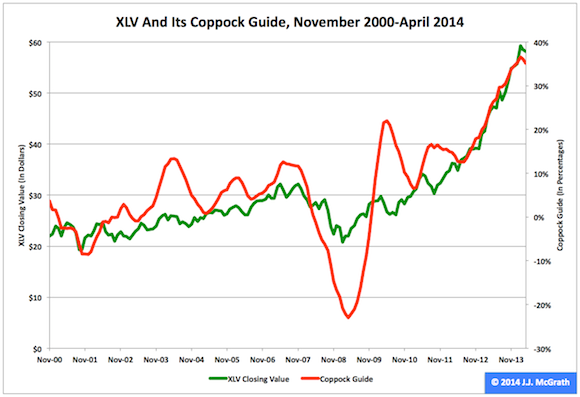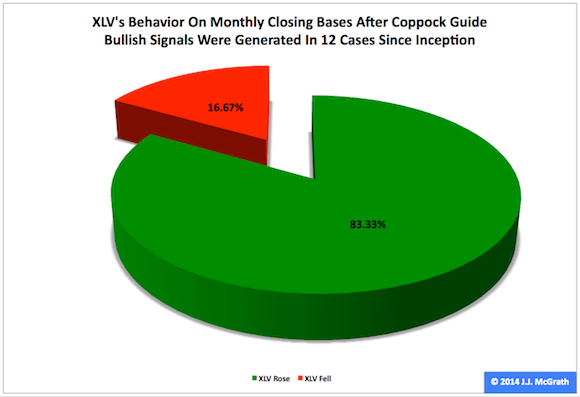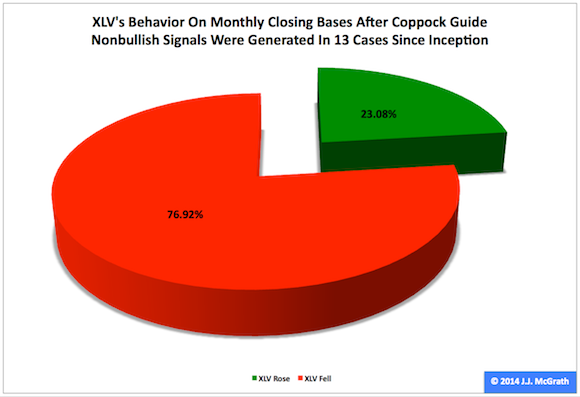The Health Care Select Sector SPDR exchange-traded fund (XLV) was No. 3 by return among
the ETFs that divide the S&P 500 into nine pieces during the first third of
this year, as its adjusted closing share price climbed to $58.12 from $55.25, a
hike of $2.87, or 5.19 percent.
Over this period, XLV’s return was a bit more than one-third
that of the Utilities SPDR ETF (XLU)
and a bit more than twice that of the SPDR S&P 500 ETF (SPY), as described in “XLU Coppock Guide: Bullish as of May Day 2014.”
(XLU returned 14.74 percent, and SPY returned 2.41 percent.)
XLV is the third of 13 ETFs to be featured in a J.J.’s Risky
Business blog series this month. Basically, I will be looking at each
ETF with both eyes fixed on its Coppock guide, as was the case in “SPY Coppock Guide: Away From Bullishness, Toward
Nonbullishness as of March 31, 2014.”
The Coppock guide, aka either the Coppock curve or the
Coppock indicator, is a long-term indicator of price movements in major
stock-market indexes introduced by Edwin S. Coppock in Barron’s more than half a century ago. The indicator’s history and
methodology are interesting in themselves, but my focus now is on its relevance
to XLV.
Figure 1: XLV And Its
Coppock Guide, The Complete History
Note: The XLV
closing-value scale is on the left, and the Coppock guide scale is on the
right.
Source: This J.J.’s
Risky Business chart is based on
proprietary analyses of Yahoo Finance adjusted monthly share-price data and those data themselves.
Coppock developed his long-term guide not to flash both
bullish and bearish signals but to generate only bullish signals. However, I
employ it to produce either bullish or nonbullish signals. It is extremely
important to keep in mind that a nonbullish signal is not equivalent to a bearish signal in the context of the Coppock
guide.
I anticipate XLV may rise after a bullish signal and expect
it might do anything following a nonbullish signal (i.e., trade higher, lower
or sideways).
Figure 2: XLV’s
Behavior Subsequent To Initial Bullish Signals
Source: This J.J.’s
Risky Business chart is based on
proprietary analyses of Yahoo Finance adjusted monthly share-price data.
The XLV Coppock guide’s initial bullish signals collectively
have done an excellent job in forecasting the future upward movements of the
ETF on monthly closing bases. In 12 cases since November 2000, these signals
have been correct on 10 occasions, or 83.33 percent of the time, and incorrect
on two occasions, or 16.67 percent of the time.
The Coppock guide’s latest initial bullish signal is
associated with XLV’s adjusted closing share price ascending to $59.24 this
February from $36.85 in June 2012, a fast and furious skyrocketing of $22.39,
or 60.76 percent. I attribute most of this movement to market participants' perceptions of the U.S. Affordable Care
Act, aka Obamacare, and Federal Reserve monetary policies.
Obamacare’s constitutionality was established
in the landmark National Federation of
Independent Business v. Sebelius decision handed down by the U.S.
Supreme Court on June 28, 2012, as noted by the court. And the Fed’s
current quantitative-easing program was announced by the Federal Open Market
Committee on Sept. 13 of the same year, as pointed out in “SPY, MDY And IJR At The Fed's QE3+ Market Top.”
To appropriate an old New Jersey marketing slogan,
“Fundamental Analysis And Technical Analysis: Perfect Together.”
Figure 3: XLV’s Behavior
Subsequent To Initial Nonbullish Signals
Source: This J.J.’s
Risky Business chart is based on
proprietary analyses of Yahoo Finance adjusted monthly share-price data.
The XLV Coppock guide’s initial nonbullish signals
collectively also have established an interesting track record when evaluated
on monthly closing bases. Again, it is extremely important to keep in mind that
a nonbullish signal is not equivalent
to a bearish signal in the context of the Coppock guide. Nonetheless, after the
flashing of 13 nonbullish signals since November 2000, the ETF’s share
price fell on 10 occasions, or 76.92 percent of the time, and rose on three
occasions, or 23.08 percent of the time.
The Coppock guide’s most recent initial nonbullish signal
was generated in February, when XLV’s closing share price was $59.24. Accounting
for the one-month lag in the confirmation of any signal, I note the ETF’s
closing share price dipped to $58.12 in April, which is clearly nonbullish
action by any standard.
Consistent with the XLV Coppock guide’s current status, I
believe in the foreseeable future the ETF may not behave absolutely well, but
might perform relatively well. On the one hand, the Affordable Care Act appears
to be less of a tailwind and the Fed’s monetary policies seem to be more of a headwind
at present than in the recent past. On the other hand, XLV, XLU and the
Consumer Staples ETF (XLP) historically
have done better than have the other Select Sector SPDRs when the market has
exited risk-on mode and entered risk-off mode, a transition I think is under
way, as indicated in “Building A Martin
Zweig-Like Fed Indicator Integrating Innovations Of The 21st Century.”
I suspect the fact XLU and XLV are already two of the top
three Select Sector SPDRs as
measured by return this year is anything but a coincidence.
Coppock Guide: The Blog
Series
Author’s Note: This is
the third blog post in a May series centered on the Coppock guides of 13
important ETFs, among them all nine Select Sector SPDRs. The first was
cross-posted at both J.J.’s Risky Business and
J.J. McGrath’s Instablog on Seeking Alpha, but the rest of the series will be posted at the former location. You
can follow me (and the series) @JJMcGrath3000 on Twitter, at JJMcGrath on StockTwits and via myself on Google+.
Disclaimer: The opinions
expressed herein by the author do not constitute an investment recommendation,
and they are unsuitable for employment in the making of investment decisions.
The opinions expressed herein address only certain aspects of potential
investment in any securities and cannot substitute for comprehensive investment
analysis. The opinions expressed herein are based on an incomplete set of
information, illustrative in nature, and limited in scope. In addition, the
opinions expressed herein reflect the author’s best judgment as of the date of
publication, and they are subject to change without notice.



No comments:
Post a Comment